ignition Acura RL 2005 Manual Online
[x] Cancel search | Manufacturer: ACURA, Model Year: 2005, Model line: RL, Model: Acura RL 2005Pages: 394, PDF Size: 5.2 MB
Page 338 of 394

CONT INUED
If you have a f lat tire while driving,
stop in a saf e place to change it.
Drive slowly along the shoulder until
you get to an exit or an area to stop
that is far away from the traffic lanes.Park the vehicle on f irm, level, and
non-slippery ground. Put the
transmission in Park. Apply the
parking brake.Take the tool case out of the spare
tire.
Turn on the hazard warning lights,
and turn the ignition switch to
LOCK (0). Have all passengers get
out of the vehicle while you
change the tire. Open the trunk, and f old the trunk
floor forward.
Unscrew the wing bolt, and
remove the spacer cone. Then
take the spare tire out of its well.
1.
2.
3.
4.
5.
Changing a Flat T ire
T aking Care of t he Unexpect ed
337
SPARE TIRE
TRUNK FLOOR
TOOL CASE JACK
The vehicle can easily roll off
the jack, seriously injuring
anyone underneath.
Follow the directions for
changing a tire exactly, and
never get under the vehicle
when it is supported only by the
jack.
Page 342 of 394

You hear nothing, or almost
nothing. The engine’s starter
motor does not operate at all, or
operates very slowly.
You can hear the starter motor
operating normally, or the starter
motor sounds like it is spinning
f aster than normal, but the engine
does not start up and run.When you turn the ignition switch to
START (III), you do not hear the
normal noise of the engine trying to
start. You may hear a clicking sound
or series of clicks, or nothing at all.
Turn the ignition switch to START
(III). If the headlights do not dim,
check the condition of the f uses. If
thefusesareOK,thereis
probably something wrong with
the electrical circuit f or the
ignition switch or starter motor.
You will need a qualif ied
technician to determine the
problem (see
on page ).
If the headlights dim noticeably or
go out when you try to start the
engine, either the battery is
discharged or the connections are
corroded. Check the condition of
the battery and terminal
connections (see page ). You
canthentryjumpstartingthe
vehicle from a booster battery
(see page ).
Check these things:
Make sure the remote is with you,
inside the vehicle.
Diagnosing why the engine won’t
start f alls into two areas, depending
on what you hear when you turn the
ignition switch to START (III):
Check the transmission interlock.
The transmission must be in Park
or neutral or the starter will not
operate.
Turn the ignition switch to ON (II).
Turn on the headlights, and check
their brightness. If the headlights
areverydimordonotcomeonat
all, the battery is discharged. Seeon page .343 343
360
331
Nothing Happens or the Starter
Motor Operates Very Slowly
Emergency T owing
Jump Starting
If theEngineWon’tStart
T aking Care of t he Unexpect ed
341
Page 343 of 394
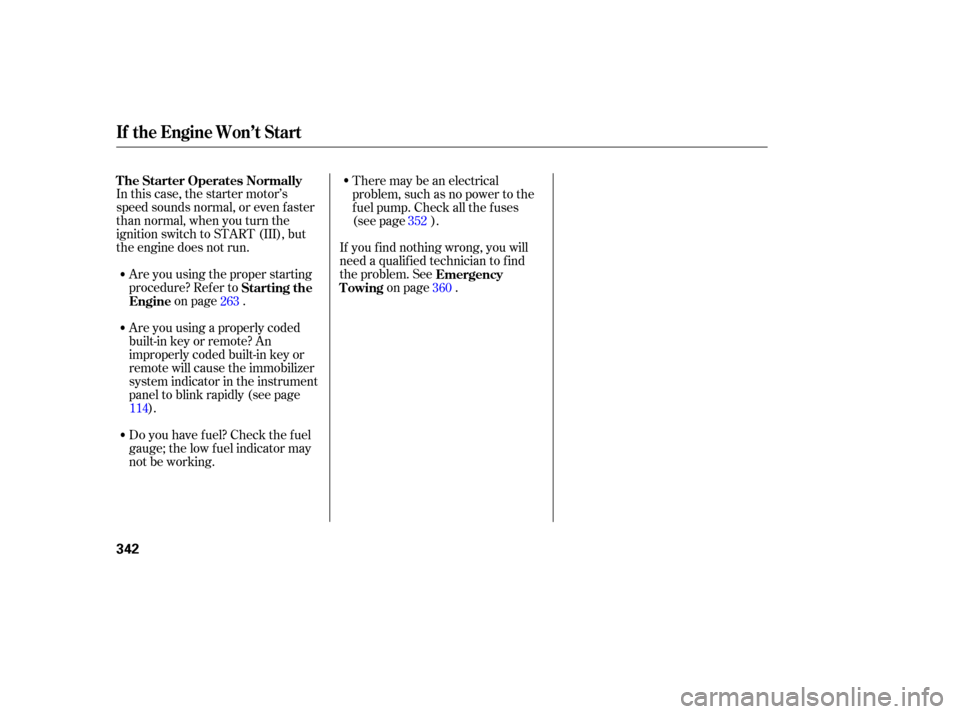
In this case, the starter motor’s
speed sounds normal, or even f aster
than normal, when you turn the
ignition switch to START (III), but
the engine does not run.Are you using the proper starting
procedure? Ref er to on page . There may be an electrical
problem, such as no power to the
f uel pump. Check all the f uses
(see page ).
If youfindnothingwrong,youwill
need a qualif ied technician to f ind
the problem. See on page .
Are you using a properly coded
built-in key or remote? An
improperly coded built-in key or
remote will cause the immobilizer
system indicator in the instrument
panel to blink rapidly (see page ).
Do you have f uel? Check the f uel
gauge; the low f uel indicator may
not be working. 114 263
352
360
T he Starter Operates Normally
Starting the
Engine Emergency
Towing
If theEngineWon’tStart
342
Page 350 of 394

To check if they are set, turn the
ignition to ON (II), without starting
the engine. The malf unction
indicator lamp will come on f or 20
seconds. If it then goes of f , the
readiness codes are set. If it blinks 5
times, the readiness codes are not
set. If possible, do not take your
vehicle f or a state emissions test
until the readiness codes are set.
Refer to
f or more inf ormation (see page ). If your vehicle battery has been
disconnected or gone dead, these
codes are erased. If takes at least
three days of normal driving to set
the codes again.
Your vehicle has certain ‘‘readiness
codes’’ that are part of the on-board
diagnostics f or the emissions
systems. In some states, part of the
emissions testing is to make sure
these codes are set. If they are not
set, the test cannot be completed.
If you have recently ref ueled your
vehicle, the indicator coming on
could be due to a loose or missing
f uel f ill cap. You will also see a
‘‘CHECK FUEL CAP’’ message on
the multi-information display.
Tighten the cap until it clicks at least
once (see page ). Tightening the
cap will not turn the indicator of f
immediately; it takes at least three
days of normal driving. If this indicator comes on
while driving, or if you see
a ‘‘CHECK EMISSION
SYSTEM’’ message on the multi-
inf ormation display, it means one of
the engine’s emissions control
systems may have a problem. Even
though you may f eel no dif f erence in
your vehicle’s perf ormance, it can
reduce your f uel economy and cause
increased emissions. Continued
operation may cause serious damage. If the indicator comes on repeatedly,
even though it may go of f as you
continue driving, have the vehicle
checked by your dealer as soon as
possible.
374
249 State Emissions T esting
Readiness Code
Malf unction Indicator L amp
T aking Care of t he Unexpect ed
349
If you keep driving with the
malf unction indicator lamp on, you can
damage your vehicle’s emissions
controls and engine. Those repairs may
not be covered by your vehicle’s
warranties.
Page 351 of 394
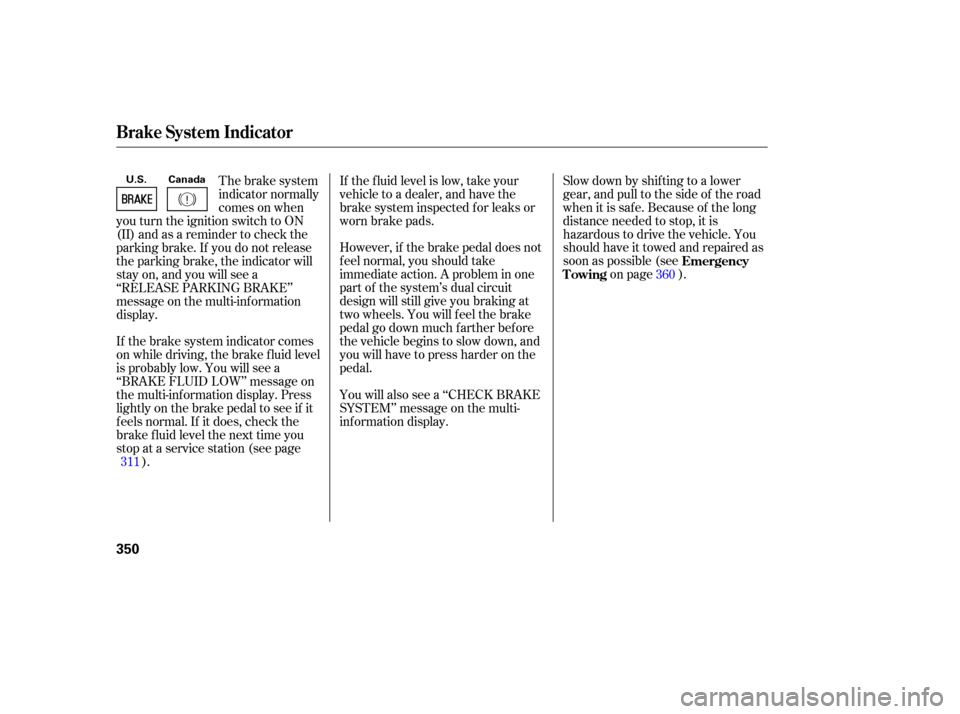
However, if the brake pedal does not
f eel normal, you should take
immediate action. A problem in one
part of the system’s dual circuit
design will still give you braking at
two wheels. You will f eel the brake
pedal go down much f arther bef ore
the vehicle begins to slow down, and
you will have to press harder on the
pedal.Slow down by shif ting to a lower
gear, and pull to the side of the road
when it is saf e. Because of the long
distance needed to stop, it is
hazardous to drive the vehicle. You
should have it towed and repaired as
soon as possible (see
on page ).
If the f luid level is low, take your
vehicle to a dealer, and have the
brake system inspected f or leaks or
worn brake pads.
You will also see a ‘‘CHECK BRAKE
SYSTEM’’ message on the multi-
inf ormation display.
If the brake system indicator comes
on while driving, the brake f luid level
is probably low. You will see a
‘‘BRAKE FLUID LOW’’ message on
the multi-information display. Press
lightly on the brake pedal to see if it
f eels normal. If it does, check the
brake f luid level the next time you
stop at a service station (see page
). The brake system
indicator normally
comes on when
you turn the ignition switch to ON
(II) and as a reminder to check the
parking brake. If you do not release
the parking brake, the indicator will
stay on, and you will see a
‘‘RELEASE PARKING BRAKE’’
message on the multi-inf ormation
display. 360
311 Emergency
Towing
Brake System Indicator
350
U.S. Canada
Page 355 of 394
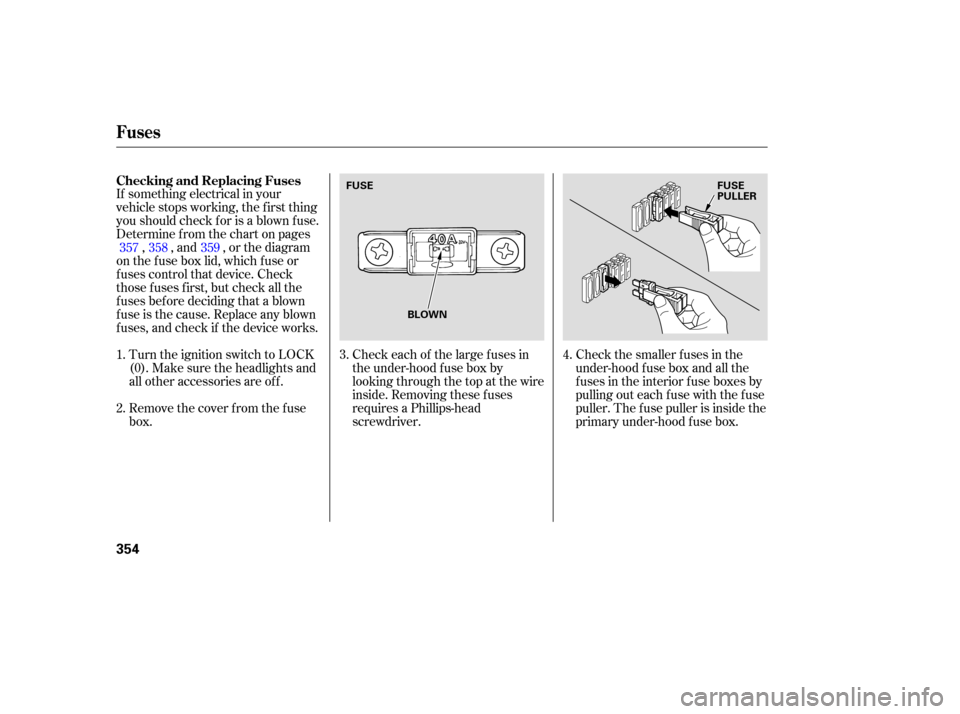
Turn the ignition switch to LOCK
(0). Make sure the headlights and
all other accessories are off.
Remove the cover f rom the f use
box.
If something electrical in your
vehicle stops working, the first thing
youshouldcheckforisablownfuse.
Determine f rom the chart on pages
, , and , or the diagram
on the f use box lid, which f use or
f uses control that device. Check
those fuses first, but check all the
f uses bef ore deciding that a blown
f use is the cause. Replace any blown
f uses, and check if the device works.
Check each of the large f uses in
the under-hood f use box by
looking through the top at the wire
inside. Removing these f uses
requires a Phillips-head
screwdriver.Check the smaller f uses in the
under-hood f use box and all the
fuses in the interior fuse boxes by
pulling out each f use with the f use
puller. The f use puller is inside the
primary under-hood f use box.
3.
4.
1.
2. 357
359
358
Checking and Replacing Fuses
Fuses
354
FUSE
BLOWN FUSE
PULLER
Page 357 of 394
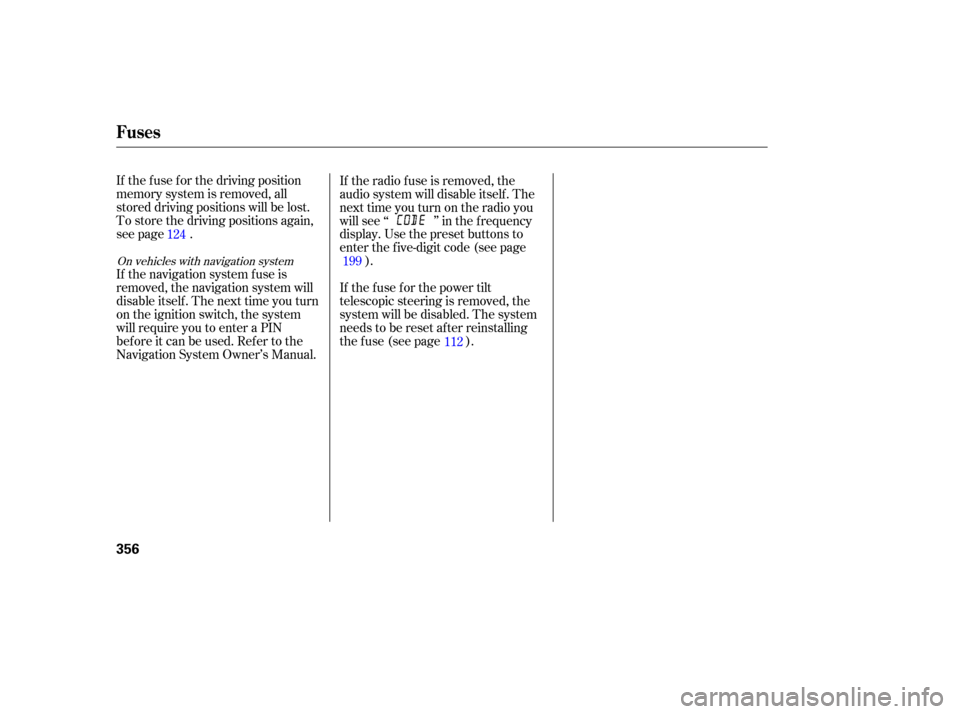
If thefuseforthedrivingposition
memory system is removed, all
stored driving positions will be lost.
To store the driving positions again,
see page .
If the navigation system f use is
removed, the navigation system will
disableitself.Thenexttimeyouturn
on the ignition switch, the system
will require you to enter a PIN
bef ore it can be used. Ref er to the
Navigation System Owner’s Manual.If the radio f use is removed, the
audio system will disable itself . The
nexttimeyouturnontheradioyou
will see ‘‘ ’’ in the f requency
display. Use the preset buttons to
enter the f ive-digit code (see page
).
If thefuseforthepowertilt
telescopic steering is removed, the
system will be disabled. The system
needs to be reset af ter reinstalling
thefuse(seepage ).
124
199
112
On vehicles with navigation system
Fuses
356
Page 359 of 394
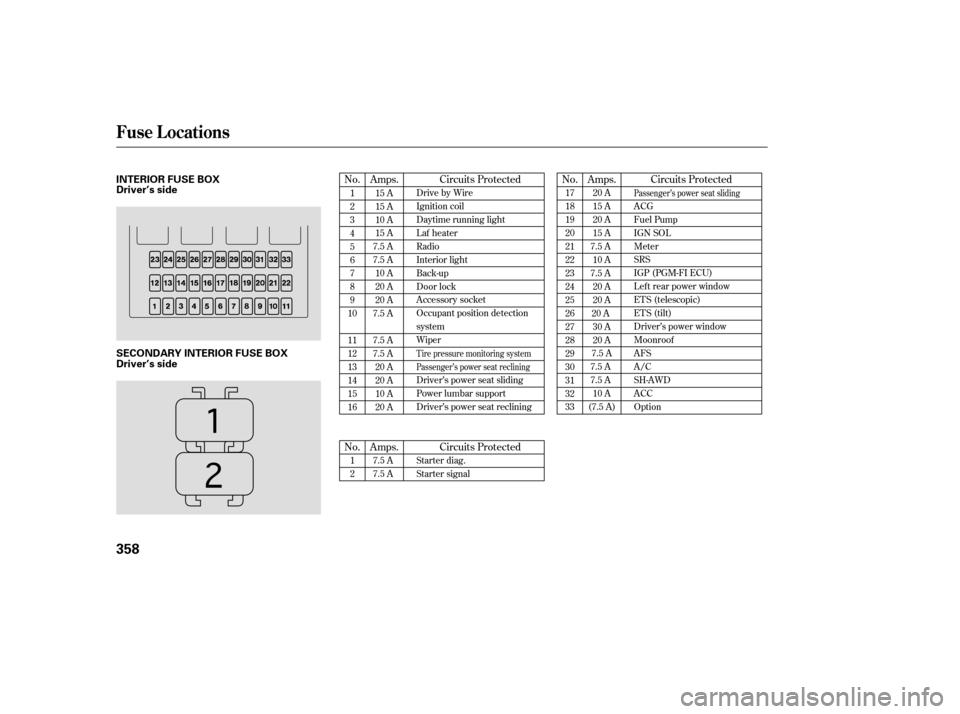
No. Amps.No. Amps.
No. Amps. Circuits Protected Circuits Protected
Circuits Protected
1
2
3
4
5
6
7
8
9
10
11
12
13
14
15
16 15 A
15 A
10 A
15 A
7.5 A
7.5 A 10 A
20 A
20 A
7.5 A
7.5 A
7.5 A 20 A
20 A
10 A
20 A 17
18
19
20
21
22
23
24
25
26
27
28
29
30
31
32
3320 A
15 A
20 A
15 A
7.5 A 10 A
7.5 A 20 A
20 A
20 A 30 A
20 A
7.5 A
7.5 A
7.5 A 10 A
(7.5 A)
1
2 7.5 A
7.5 A Starter diag.
Starter signal DrivebyWire
Ignition coil
Daytime running light
Laf heater
Radio
Interior light
Back-up
Door lock
Accessory socket
Occupant position detection
system
Wiper
Driver’s power seat sliding
Power lumbar support
Driver’s power seat reclining ACG
Fuel Pump
IGN SOL
Meter
SRS
IGP (PGM-FI ECU)
Left rear power window
ETS (telescopic)
ETS (tilt)
Driver’s power window
Moonroof
AFS
A/C
SH-AWD
ACC
Option
Tire pressure monitoring system
Passenger’s power seat reclining
Passenger’s power seat sliding
Fuse Locations
358
INTERIOR FUSE BOX
Driver’s side
SECONDARY INTERIOR FUSE BOX
Driver’s side
Page 364 of 394

................
Identif ication Numbers . 364
................................
Specif ications .366
DOT Tire Quality Grading ......................
(U.S. Vehicles) .368
.................................
Treadwear .368
......................................
Traction .368
.............................
Temperature .369
.................................
Tire Labeling .370 .......................
Emissions Controls .371
.....................
The Clean Air Act .371
Crankcase Emissions Control ....................................
System .371
Evaporative Emissions Control ....................................
System .371
Onboard Ref ueling Vapor ................................
Recovery .371
...
Exhaust Emissions Controls . 372
....................
PGM-FI System .372
Ignition Timing Control ................................
System .372
Exhaust Gas Recirculation ...................
(EGR) System . 372
Three Way Catalytic ...........................
Converter .372
....................
Replacement Parts . 372
..
Three Way Catalytic Converter . 373
..............
State Emissions Testing . 374
Thediagramsinthissectiongive
you the dimensions and capacities of
your vehicle, and the location of
identif ication numbers. It also
includes inf ormation you should
know about your vehicle’s tires and
emissions control systems.
T echnical Inf ormat ion
T echnical Inf ormation
363
Page 373 of 394

The exhaust emissions controls
include f our systems: PGM-FI,
ignition timing control, exhaust gas
recirculation, and three way catalytic
converter. These f our systems work
together to control the engine’s
combustion and minimize the
amount of HC, CO, and NOx that
comes out the tailpipe. The exhaust
emissions control systems are
separate f rom the crankcase and
evaporative emissions control
systems.
The PGM-FI system uses sequential
multiport f uel injection.
It has three subsystems: air intake,
engine control, and f uel control. The
powertrain control module (PCM)
uses various sensors to determine
how much air is going into the
engine. It then controls how much
f uel to inject under all operating
conditions.This system constantly adjusts the
ignition timing, reducing the amount
of HC, CO, and NOx produced.
The exhaust gas recirculation (EGR)
system takes some of the exhaust
gas and routes it back into the intake
manif old. Adding exhaust gas to the
air/f uel mixture reduces the amount
of NOx produced when the f uel is
burned.
The emissions control systems are
designed and certif ied to work
together in reducing emissions to
levels that comply with the Clean Air
Act. To make sure the emissions
remain low, you should use only new
Acura replacement parts or their
equivalent f or repairs. Using lower
qualitypartsmayincreasethe
emissions f rom your vehicle.
The emissions control systems are
covered by warranties separate from
the rest of your vehicle. Read your
warranty manual f or more informa-
tion.
The three way catalytic converters
are in the exhaust system. Through
chemical reactions, they convert HC,
CO, and NOx in the engine’s exhaust
to carbon dioxide (CO ), nitrogen
(N ), and water vapor.
2
2
Emissions Cont rols
Exhaust Emissions Controls Replacement Parts
PGM-FI Syst emIgnit ion T iming Cont rol Syst em
Exhaust Gas Recirculat ion (EGR)Syst em
Three Way Catalytic Converter
372